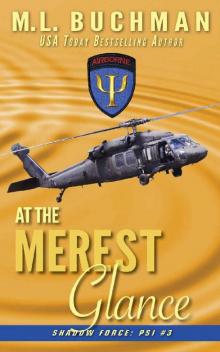- Home
- M. L. Buchman
Man the Guns, My Mate
Man the Guns, My Mate Read online
Man the Guns, my mate
a Night Stalkers romance story
by M. L. Buchman
1
Roy Wilkinson won the lottery.
Finally!
For a decade he’d entered the drawing to board the USS Constitution for her yearly “Turnaround Cruise”—the one time each year that the majestic sailing ship left dock and crisscrossed Boston Harbor. At the midpoint, she’d fire off a cannonade in salute to old Fort Independence that had guarded the harbor during the Revolution and the War of 1812. At the end, she’d be docked facing the opposite direction—turned around—so that the sides of the old wooden ship would weather evenly.
Ten long years he’d had to eat his growing disappointment at not making it through the drawing for a ride on “Old Ironsides,” the greatest of the U.S. Navy’s sailing ships. He’d always brought along some of his marine engineering students to watch the event from a tour boat—the tall majestic three-master, gliding out under tow across a Boston that had looked so different when she’d leapt to her city’s defense in the War of 1812. She lost none of her nobility for moving through a harbor transformed by buildings of glass and steel rather than brick and stone.
The Constitution was scheduled into dry dock for the next couple of years and he’d been dreading that deeply if he missed the lottery this year. But he hadn’t.
Roy had certainly walked her decks enough times, but that was far different from riding aboard as she crossed the harbor, even if it was only under tow. She’d only raised her sails twice in the last century.
But now he had his “Golden Ticket,” his E-coupon, his season pass—actually, his friendly little email with a code. He was allowed one guest.
A colleague? Most of them already thought him a little off center, he really didn’t need to prove that hypothesis for them.
His sister? She was in Seattle married to a Microsoft engineer.
No, he’d go himself and simply enjoy his three-hour tour. Maybe they’d get marooned on some desert island…in Boston Harbor. He really had to get a life one of these days. Soon! Maybe he’d meet somebody there. A pretty, intelligent woman who lived in the Back Bay or Beacon Hill, was interested in old sailing ships, and ran a small but highly successful catering business.
Or maybe he’d win a free trip to the moon. The latter was far more likely.
There were certainly strings he could have pulled to get on the Turnaround Cruise sooner, but it didn’t feel right. While he wasn’t in the Navy, but rather was a professor of naval architecture, he worked with the Navy. That connection had left him with a feeling of duty to follow the honorable path to finding his own way aboard. Taking advantage of his friendships in the Navy or his MIT professorship had simply not been an ethical course.
But ten years had been a long time to wait.
That the email of his success arrived on the same day his taxes were due only made it all the sweeter. This year, some small portion of his taxes would be taking him on a cruise around Boston Harbor aboard the country’s oldest Naval vessel; only the third ever commissioned—this one by old George Washington himself.
With a heavy black marker he’d blocked out the week before July 4th on his wall calendar in addition to his electronic one to make sure he didn’t double-schedule himself, plus a day after to relish the experience. He had summer school classes to teach in the mornings, but had posted a notice weeks in advance on his door: “No office hours June 30-July 5 for Constitutional.”
Anyone who’d commented on his odd use of italics would launch him into a long-winded history of the origin of the word constitution dating back to the Latin constitutio “act of settling and order” (which itself went back to constituere “to cause to stand”) and the “al” being a Johnny-come-lately addition in the 1670s.
Torturing students and colleagues was just one of the many fine perks of a tenured MIT professorship.
Roy mapped out his plan of attack. While still in college—rather than teaching it—he’d purchased and read most of the books on the design of the Constitution and her famous career. But to truly appreciate every aspect of his cruise along with a hundred and fifty other lucky lottery winners, he now prepared to immerse himself each day after teaching.
He would start with a brief tour of the ship. Then he’d plunge into the museum for two days and gather everything he could there. Afterwards, he’d spend July second and third aboard the ship, going over her carefully, from Humphrey’s forward-thinking design choices starting at the keel to her most recent restorations of the original curvature to the Spar Deck to aid in rainwater shedding.
He knew it was being ridiculously anal, but he’d gone to the local craft and farmer’s market and found a hand-sewn tooled-leather journal to record his impressions and sketches. He already owned a perfectly serviceable fountain pen, so he avoided being utterly irredeemable.
After his morning’s lecture on Naval Ship Conversion Design and hydrodynamic implications of hull extensions—something for which the modern Navy had been showing a recent penchant—he set out to stroll the two miles from campus to the Charlestown Naval Shipyard on the walking path along the Charles River Basin.
Late June at the Boston waterfront was a delightful temperature and he walked along with some anticipation of his first glimpse of the towering 220-foot tall mainmast. The modern world of a hustling, blaring Boston seemed to fade away the closer he came to the ship.
2
Commander Deborah Reynolds stepped out of her four-hundredth meeting about the upcoming Turnaround Cruise, at least it felt that way. She’d been aboard less than a week, so it was probably only the two hundredth.
And then, impossibly, as if stepping through a time machine, she climbed the stern gangway onto the wooden deck of the greatest sailing ship of the U.S. Navy. It took her breath away every time and she hoped it would never stop doing so. The three-masted frigate towered above the urban port. Hundreds of lines, over thirty-five miles of rope, held and serviced those towering sticks. She tried to imagine the wonder of the multiple booms filled with canvas, but could never quite do it. Despite the lack, the old ship rested here and still she filled tourists’ hearts with wonder.
Even though her two-year stint in command of the USS Constitution wouldn’t technically begin for four weeks, the ship already felt as if it was hers, as if they’d only been waiting for each other.
She’d been released early from her command of a Perry-class long-hull frigate because they’d decommissioned the USS Reuben James right out from under her. Despite it being a part of the planned retirement of the entire class, it had been a hard duty nonetheless. They had a final deployment down the western side of the Pacific—Japan to the Philippines—and then her ship was retired after thirty-one years. She’d ignore any ominous implications of her own age matching her ship’s.
She’d had no real hope of gaining a tour of command aboard the Constitution, but she’d certainly been trying for it. The first woman and the first of African descent to command the old sailing vessel. The former was a matter of some pride, the latter no longer seemed to matter in the modern Navy. About damned time, even if the news was making a deal out of it. She’d wanted to be known for her ability to sail, but while she’d won a lot of races, she hadn’t been Olympic level good. Being known for her ability to command was as much a surprise to herself as to the review boards that kept promoting her—she’d found a deep joy in leading a smooth-running ship and hoped to go on doing so for a long time to come.
Her two ships, technically both classed as frigates, had a few similarities and a lot of differences. Her new command was a hundred feet shorter and a hundred
and fifty taller, though nearly identical in side-to-side beam and draft depth.
Instead of two hundred crew on the James, she now commanded seventy—though Constitution had carried five hundred in her heyday. They paused from their tasks or chatting with tourists to salute her as she strolled across the quarterdeck to catch her breath. Her boots softly thumping her progress on wood rather than ringing on steel as she was used to.
The Constitution had been designed almost two hundred years earlier than the Reuben James. Wood rather than steel. She had a top speed of twelve knots, versus thirty. Forty-four twenty-four pound cannons compared with enough heavy firepower, missile power, and torpedo power to put anything other than a destroyer to shame. And her rope rigging would kill any helicopter that even thought about coming close. The Constitution lacked the pair of Seahawk helicopters that could kick some serious anti-submarine butt when needed.
But there was one overwhelming factor in the old ship’s favor. Instead of forty-one thousand shaft horsepower of roaring twin diesel engines, she ran on chunks of canvas the size of a basketball court…each. That was certainly enough to humble a girl about her new command.
Actually, this command was humbling her in a wide variety of ways; she would soon be in charge of the most visited ship of the Navy. Intrepid, Midway, Missouri, and Arizona were all decommissioned. Constitution was still a commissioned ship of the Navy since 1797. The next oldest ship was the Pueblo commissioned in 1967 and she was still in the hands of North Korea.
Deborah could feel the weight of her new command threatening to choke her as surely as the high collar of her 1812-era uniform.
“Walk the ship.” That’s what the former Reuben James commander had said to her as he’d handed over his ship to her care. “When in doubt, walk the ship and listen. She’ll talk to you.”
It was surprising how often it worked.
So, she left the wide, flat quarterdeck, and walked slowly forward.
By the great twin, spoked wheels of the helm, she received a casual salute from a tourist. He really snapped to when he realized she wasn’t just an actor inside the period uniform, which was surprisingly gratifying. He turned out to be a Navy SEAL Lieutenant. She chatted with him and his red-headed helicopter pilot girlfriend for a few moments and left feeling somewhat better and more cheerful about her new role working out. She also appreciated that bit of respect due her rank, which she’d worked damned hard to attain.
It had surprised her how often over the last week she’d received salutes from Navy personnel, and occasionally other forces’ soldiers who were touring the ship.
A naval commander was still a naval commander.
And a ship was still a ship.
If she could handle a Perry-class frigate, she could handle a sailing frigate as well.
3
Roy watched the commander work her way along the deck. He’d been up at the bow sketching the long lines of the ship as seen from the foremast hand’s perspective. Joshua Humphreys had designed the Constitution to be longer and leaner than any other fighting ship of her size. It made her fast and it made her strong, especially backed up by a two-foot thick oak hull. That was how she’d earned the nickname “Old Ironsides”—the British eighteen-pound cannon balls had bounced off her thick, well-braced sides in the first battle in the War of 1812.
The woman walking toward him had those aspects in common with the ship: long, lean, and looking impossibly strong. Her period costume only enhanced the impression. Mid-calf black leather “Hessian” boots with scalloped tops, white slacks, dark blue woolen jacket with tails, brass buttons, and a high collar making her neck appear impossibly long. A tall bicorn—a hat pointed to the front and back and folded upward into a peak on the sides—sat neatly atop her short dark hair. The twin gold tassels on her shoulders lent her a feminine air for they bounced and fluttered as she walked. They also marked her as the ship’s commander.
“If I were in the service, I’d offer you a salute, Commander. You look incredible.”
“Thank you,” her tone was pleasant but she looked at him askance with those dark eyes.
Roy reviewed his words and grimaced, “Okay, that didn’t come out right. I meant the uniform. The attention to detail is amazing. You look exactly as if you walked out of the history books.”
“Other than being black and female.”
“Well, yes, other than that.”
She almost began to move off, then paused with a half smile to herself.
“So, my uniform looks incredible.”
“Yes, sir.” He’d almost said “Yes, ma’am.” While that might have been more proper in today’s Navy, neither she nor this ship belonged in the present.
“You didn’t mean me.”
“No, sir.”
She stood there waiting, then raised her eyebrows slightly.
Oh god. Now he’d said that she wasn’t pretty, where in truth she was stunning. Her skin looked smooth and creamy, strong eyebrows, full lips, and…he absolutely needed a brain transplant. The only question was how fast could he get one. A monkey’s brain would be more adept than his. Perhaps even a gerbil’s.
“Okay,” he resisted the urge to beat himself over the head with his notebook; the ink on his sketch was still wet and would probably smear across his forehead. “A gorgeous woman in a stunning uniform is clearly beyond my capacity to process rationally. My apologies, Commander.”
4
Deborah let the laugh out. The man looked so pitiful that she couldn’t help herself.
He flushed and looked down at his notebook, which was pretty damn cute in such a handsome man. His wavy hair was nearly the same shade as her new command’s polished oaken brightwork. His dark eyes a surprising contrast. There was a neatness about him that she rather liked; as if he were ship-shape and Bristol fashion. She must be adapting to the Constitution to use such an arcane metaphor.
She looked down at his notebook.
“That’s a fine rendering.” He didn’t look like an artist with his jeans, Rockports, and a neat button-down. And then she saw that it was less of an artist’s view than… “An engineer?”
He looked back up at her in surprise. “You got me in one. Actually an engineering professor.”
“With a taste for old ships,” she could see the detailed notes down the page opposite the drawings noting rail heights, cannon distributions, rope sizes—properly noted by circumference rather than diameter. The workmanship was as neat as the man, a reflection of each other that she would wager carried through to his very core.
“I teach naval architecture at the Pratt School of Naval Architecture and Marine Engineering at MIT.”
“That explains it.”
He looked at her quizzically, but she liked keeping him off balance a bit.
“Well, I hope you enjoy your day aboard.”
“Days,” he inspected his drawing at an angle in the bright afternoon sun before closing it carefully. “I’m afraid you are going to become rather sick of me before the next seven days are over.” His smile was bright, but she could see more behind it. Something that she couldn’t identify, but was intriguing.
“Seven days?” She moved to an at-ease stance. Was he a secret government inspector? If so, he was lousy at the secret part.
“I won the lottery.”
“Congratulations. But I still can’t let you buy the USS Constitution with your winnings.”
“No, no.”
She’d known exactly what he meant, but he actually took her line straight.
“The ‘Turnaround Cruise’ lottery. Took me ten years to win. So, I want to familiarize myself as thoroughly as possible with the ship before the event.”
Deborah looked to see if he was joking. Then she looked away and looked back. But he wasn’t.
What was being the torture of her first week appeared to be the highlight of
this man’s decade.
“You love this ship that much?”
“I’m kind of a nerd that way. Did I mention: engineer?” He flipped open his notebook to reveal a drawing of the running rigging, specifically tracing how the Fore Royal Topgallant Studding sail’s outriggers were extended and retracted, starting from the deck and detailing every run and turning block to a hundred and fifty feet above the deck. Down the side were force estimate calculations to extend and retract the outriggers. It was the most complex piece of line on the entire ship.
“Perhaps I should let you command the ship as you know so much about her.”
“I know how she was designed and built, I don’t know how to sail her.”
“Can’t sail her?” Why was she teasing the man? It was not a proper military demeanor to portray to a tourist.
“I don’t know how to sail.”
“You’re a marine engineer, designing ships for the Navy, you love the Constitution, and you don’t know how to sail?”
“Well, I train students to do the designs, though I have certainly consulted for the Navy on several occasions. I’m a specialist in long-hull conversions, like the Perry-class frigates, though that wasn’t one of mine. My mentor did that one. That design was done the same year I was born.”
“My, but it’s a small world.”
“What?”
“As former commander of the USS Reuben James Perry-class long-hull, I am going to take you out tomorrow and teach you how to sail.” Now why had she gone and said that? She’d been looking forward to a quiet day off, sailing out in Boston Harbor by herself. She had a sweet little Dragon class boat rented for the day.
“I was going to spend it in the museum…” he looked doubtful. Then he smiled up at her with such a genuine grin and she was glad she’d asked. “I’d love to.”
They made arrangements to meet the next morning at nine at the marina just a few hundred meters to the west. He would bring lunch.

 White Top
White Top Thunderbolt
Thunderbolt Storm's Gift
Storm's Gift The Complete Delta Force Shooters
The Complete Delta Force Shooters At the Quietest Word (Shadowforce: Psi Book 2)
At the Quietest Word (Shadowforce: Psi Book 2) At the Slightest Sound
At the Slightest Sound Dilya's Christmas Challenge
Dilya's Christmas Challenge Raider
Raider Havoc
Havoc Carrying the Heart's Load
Carrying the Heart's Load Flying Beyond the Bar
Flying Beyond the Bar Firelights of Christmas
Firelights of Christmas Where Dreams Are Well Done
Where Dreams Are Well Done Nathan's Big Sky
Nathan's Big Sky Heart of a Russian Bear Dog
Heart of a Russian Bear Dog Drone: an NTSB / military technothriller (Miranda Chase Book 1)
Drone: an NTSB / military technothriller (Miranda Chase Book 1) Flower of Destiny
Flower of Destiny Drone
Drone Ghostrider: an NTSB-military technothriller (Miranda Chase Book 4)
Ghostrider: an NTSB-military technothriller (Miranda Chase Book 4) Wild Fire
Wild Fire Team Black Sheep
Team Black Sheep The Complete Delta Force Warriors
The Complete Delta Force Warriors At the Quietest Word
At the Quietest Word At the Merest Glance
At the Merest Glance Havoc: a political technothriller (Miranda Chase Book 7)
Havoc: a political technothriller (Miranda Chase Book 7) White Top: a political technothriller (Miranda Chase Book 8)
White Top: a political technothriller (Miranda Chase Book 8) Between Shadow and Soul
Between Shadow and Soul Island Christmas
Island Christmas Survive Until the Final Scene
Survive Until the Final Scene Midnight Trust
Midnight Trust Return to Eagle Cove
Return to Eagle Cove Where Dreams Reside
Where Dreams Reside Honor Flight
Honor Flight Where Dreams Are Sewn
Where Dreams Are Sewn The Complete Hotshots
The Complete Hotshots Condor
Condor I Own the Dawn
I Own the Dawn Chinook
Chinook At the Merest Glance: a military paranormal romance (Shadowforce: Psi Book 3)
At the Merest Glance: a military paranormal romance (Shadowforce: Psi Book 3) Since the First Day
Since the First Day Thunderbolt: an NTSB / military technothriller (Miranda Chase Book 2)
Thunderbolt: an NTSB / military technothriller (Miranda Chase Book 2) For Her Dark Eyes Only
For Her Dark Eyes Only Play the Right Cards
Play the Right Cards Lost Love Found in Eagle Cove
Lost Love Found in Eagle Cove Big Sky Ever After: a Montana Romance Duet
Big Sky Ever After: a Montana Romance Duet Keepsake for Eagle Cove
Keepsake for Eagle Cove At the Clearest Sensation
At the Clearest Sensation The Ides of Matt 2015
The Ides of Matt 2015 When They Just Know
When They Just Know Cave Rescue Courtship
Cave Rescue Courtship Wildfire at Dawn
Wildfire at Dawn Dawn Flight
Dawn Flight Blaze Atop Swallow Hill Lookout
Blaze Atop Swallow Hill Lookout The Sword of Io
The Sword of Io Christmas at Steel Beach
Christmas at Steel Beach Heart's Refuge
Heart's Refuge By Break of Day (The Night Stalkers)
By Break of Day (The Night Stalkers) Kee's Wedding
Kee's Wedding Just Shy of a Dream
Just Shy of a Dream Path of Love
Path of Love Ghost of Willow's Past
Ghost of Willow's Past Flash of Fire
Flash of Fire Target of the Heart
Target of the Heart Sound of Her Warrior Heart
Sound of Her Warrior Heart Target of Mine: The Night Stalkers 5E (Titan World Book 2)
Target of Mine: The Night Stalkers 5E (Titan World Book 2) The Complete Where Dreams
The Complete Where Dreams Target of One's Own
Target of One's Own For All Their Days
For All Their Days Pure Heat
Pure Heat Love's Second Chance
Love's Second Chance Target Engaged
Target Engaged Bring On the Dusk
Bring On the Dusk Wait Until Dark (The Night Stalkers)
Wait Until Dark (The Night Stalkers) Big Sky, Loyal Heart
Big Sky, Loyal Heart Welcome at Henderson's Ranch
Welcome at Henderson's Ranch Damien's Christmas
Damien's Christmas Flight to Fight
Flight to Fight Nara
Nara Looking for the Fire
Looking for the Fire Love Behind the Lines
Love Behind the Lines Peter's Christmas
Peter's Christmas In the Weeds
In the Weeds Christmas at Henderson's Ranch
Christmas at Henderson's Ranch They'd Most Certainly Be Flying
They'd Most Certainly Be Flying Fire at Gray Wolf Lookout (Firehawks Book 8)
Fire at Gray Wolf Lookout (Firehawks Book 8) Wildfire on the Skagit (Firehawks Book 9)
Wildfire on the Skagit (Firehawks Book 9) A Hotshot Christmas
A Hotshot Christmas Off the Leash
Off the Leash Where Dreams Books 1-3
Where Dreams Books 1-3 Guardian of the Heart
Guardian of the Heart The Ides of Matt 2017
The Ides of Matt 2017 Where Dreams Unfold
Where Dreams Unfold Twice the Heat
Twice the Heat Wild Justice (Delta Force Book 3)
Wild Justice (Delta Force Book 3) Flying Over the Waves
Flying Over the Waves Love in the Drop Zone
Love in the Drop Zone I Own the Dawn: The Night Stalkers
I Own the Dawn: The Night Stalkers What the Heart Holds Safe (Delta Force Book 4)
What the Heart Holds Safe (Delta Force Book 4) The Christmas Lights Objective
The Christmas Lights Objective Road to the Fire's Heart
Road to the Fire's Heart Night Rescue
Night Rescue Delta Mission: Operation Rudolph
Delta Mission: Operation Rudolph Full Blaze
Full Blaze Night Is Mine
Night Is Mine Lightning Strike to the Heart
Lightning Strike to the Heart Beale's Hawk Down
Beale's Hawk Down Circle 'Round
Circle 'Round Cookbook from Hell Reheated
Cookbook from Hell Reheated Zachary's Christmas
Zachary's Christmas Reaching Out at Henderson's Ranch
Reaching Out at Henderson's Ranch Fire Light Fire Bright
Fire Light Fire Bright The Ides of Matt 2016
The Ides of Matt 2016 Her Heart and the Friend Command
Her Heart and the Friend Command On Your Mark
On Your Mark Swap Out!
Swap Out! Heart of the Cotswolds: England
Heart of the Cotswolds: England The Phoenix Agency_The Sum Is Greater
The Phoenix Agency_The Sum Is Greater Wildfire at Larch Creek
Wildfire at Larch Creek Target Lock On Love
Target Lock On Love Second Chance Rescue
Second Chance Rescue Where Dreams Are Written
Where Dreams Are Written First Day, Every Day
First Day, Every Day Christmas at Peleliu Cove
Christmas at Peleliu Cove Heart Strike
Heart Strike Man the Guns, My Mate
Man the Guns, My Mate Emily's Wedding
Emily's Wedding Daniel's Christmas
Daniel's Christmas Frank's Independence Day
Frank's Independence Day The Phoenix Agency: The Sum Is Greater (Kindle Worlds Novella)
The Phoenix Agency: The Sum Is Greater (Kindle Worlds Novella) Roy's Independence Day
Roy's Independence Day